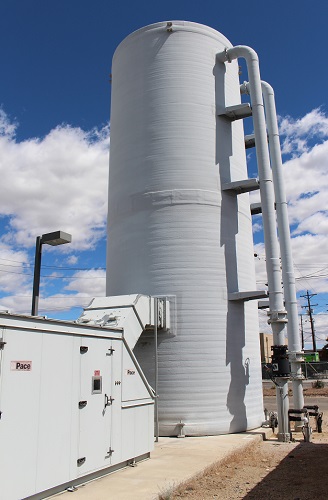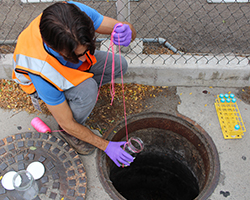Our Work: Current Activities & Projects
The Central Truckee Meadows Remediation District (CTMRD) program is implemented by the Washoe County Community Services Department (WCCSD) on behalf of the Board of County Commissioners (BCC). A team of WCCSD staff leads the CTMRD program efforts described below.
Remediation Management Plan Update
The Remediation Management Plan (RMP) guides the activities of the CTMRD program. The RMP is required by state statute (NRS 540A.260). It provides background on the program, delineates boundaries, identifies program goals and objectives, and defines roles and responsibilities of stakeholder agencies: WCCSD, City of Reno, City of Sparks, Truckee Meadows Water Authority (TMWA), Washoe County Health District (WCHD), and Nevada Division of Environmental Protection (NDEP).
An update to the RMP is in the process of being completed. Periodic updates to the RMP are required by the BCC and NDEP.
Groundwater Monitoring Plan
The Groundwater Monitoring Plan (GMP) was implemented in December 2003, and was revised in 2010. The GMP is the framework for the CTMRD network of over 200 groundwater monitoring wells, including installation of new wells, collection of groundwater quality samples, measurement of groundwater physical parameter, and data analysis.
The GMP Program Report summarizes the methods, results, and findings related to CTMRD groundwater sampling. The report includes the current understanding of groundwater and contaminant movement in the central Truckee Meadows, an inventory of data gaps in that understanding, and a summary of planned and recommended activities to address those gaps. The GMP Report is updated periodically as new information and developments occur.
Groundwater Elevation Monitoring
As a component of the GMP, monthly groundwater elevation data are collected by CTMRD program staff from monitoring wells in the Central Truckee Meadows (CTM) and by Truckee Meadows Water Authority (TMWA) from their municipal water supply wells and monitoring wells; the TMWA data are typically provided to WCCSD quarterly. The combined groundwater elevation data set is uploaded to the electronic database at the end of each quarter.
Groundwater Quality Monitoring
Another component of the GMP quarterly groundwater monitoring activities is the collection of water quality samples and field measurement of groundwater physical parameters.
GMP Quarterly Monitoring Report
The primary objectives of the GMP quarterly monitoring report are to:
- Characterize and evaluate contaminant impacts to groundwater;
- Help identify and characterize areas where potential PCE sources are located;
- Identify potential threats posed by PCE to potential receptors in the CTM;
- Support periodic updates to the subregion conceptual site models;
- Identify critical data gaps to the understanding of PCE occurrence and migration in the CTM; and
- Provide recommendations for activities to address data gaps.
The report also includes regional-scale groundwater elevation and tetrachloroethene (PCE) and trichloroethene (TCE) concentration contour maps, and a map of the observed vertical groundwater potentiometric difference between the shallow and deep zones.
PCE Wellhead Remediation
 Wellhead PCE remediation ensures the delivery of safe drinking water and is considered a cost-effective method of remediating the PCE contamination we have in the deep zone of the Truckee Meadows aquifer system.
Wellhead PCE remediation ensures the delivery of safe drinking water and is considered a cost-effective method of remediating the PCE contamination we have in the deep zone of the Truckee Meadows aquifer system.
TMWA owns more than 80 municipal water supply wells in southern Washoe County. Five of their wells located in the Central Truckee Meadows have Washoe County-owned PCE remediation systems in place. These systems remove PCE from groundwater using a process called air stripping. PCE removal by air stripping has been taking place in the Truckee Meadows since 1996. The CTMRD program funds the ongoing operation and maintenance of wellhead remediation at these PCE-impacted wells. The program will also fund future required wellhead remediation, including design, construction, and operation and maintenance necessary for other supply wells impacted by legacy PCE.
TMWA and Washoe County have jointly developed a Remediation Agreement, which describes responsibilities for operation and maintenance of PCE wellhead remediation, and a pumping plan that defines the quantity and schedule for groundwater pumping at the five PCE-impacted municipal water supply wells. By meeting the specified pumping schedule and target volumes, not only is PCE is removed from drinking water, but pumping also helps prevent the potential migration of PCE in the aquifer system. This protects the uncontaminated portions of the aquifer system and the other water supply wells located down-gradient from PCE plumes.
PCE Source Management
Effective management of PCE sources is requisite for the management and mitigation of existing groundwater plumes. Source management focuses on goals that:
- Prevent groundwater contamination from current PCE users;
- Protect human health and the environment from releases that have occurred; and
- Mitigate historical sources of PCE in groundwater that aren't subject to city, state, or other regulations.
1. Preventing Contamination from Current PCE Users

City of Reno and City of Sparks are the lead regulatory and outreach agencies for current dry cleaners and other PCE-using businesses. They are the “boots on the ground” when it comes to providing information about PCE use and disposal requirements and are the one of the first lines of defense for reducing or eliminating PCE discharges to the environment.
The Cities and WCCSD jointly administer the Sewer Monitoring Program (SMP) which is designed to verify compliance with existing regulations that prohibit the discharge of PCE into the storm water and sanitary sewer systems.
2. Corrective Actions
If activities on a specific property have been identified as the source for PCE groundwater contamination, the property is referred to the Nevada Division of Environmental Protection's (NDEP) Bureau of Corrective Actions. NDEP regulatory options for corrective action sites include characterization and possible clean-up of the contamination.
3. Potential Source Area (PSA) Investigations
Investigating and characterizing legacy sources of PCE-contaminated groundwater is ongoing, with the CTMRD program leading the effort. These investigations focus on sources of contamination that cannot be attributed to a specific user or a responsible party. There are currently six potential source areas (PSAs) under investigation in the central Truckee Meadows:
- Mill/Kietzke PSA - near the intersection of Mill Street and Kietzke Lane in Reno
- Vassar/E. Plumb PSA - the area along S. Virginia Street between Vassar Street and Plumb Lane in Reno
- West Fourth Street PSA - the old commercial and industrial corridor in Downtown Reno
- Downtown Sparks PSA - the old commercial and industrial corridor in Downtown Sparks
- El Rancho PSA - the area south of Oddie Boulevard between El Rancho Drive and Sullivan Lane in Sparks
- Joule PSA - located in the area bordered by Rock Boulevard, Mill Street, and Edison Way
Investigation activities include passive soil gas (PSG) sampling and/or active soil gas (ASG) sampling to characterize the PCE contamination above groundwater. As data are collected and analyzed, any area found to exhibit significantly high concentrations of PCE contamination is assessed and considered for remedial action. High mass areas are of particular interest as these areas may have soil PCE concentrations at levels that can cause groundwater PCE concentrations to exceed the drinking water standard.
Outreach
Effective outreach is one of the four major objectives of the CTMRD program. CTMRD program staff and stakeholder agencies are committed to proactively communicating with each other, policy makers, affected business sectors, media, and the public about events, programs, and other efforts.
Stakeholder agencies meet with local community groups, including Citizen Advisory Boards. We are available to make presentations to groups interested in learning more about the CTMRD program and groundwater in the central Truckee Meadows -- please contact Brian Bass, Interim Program Manager, at bbass@washoecounty.gov or 775.954.4637.
